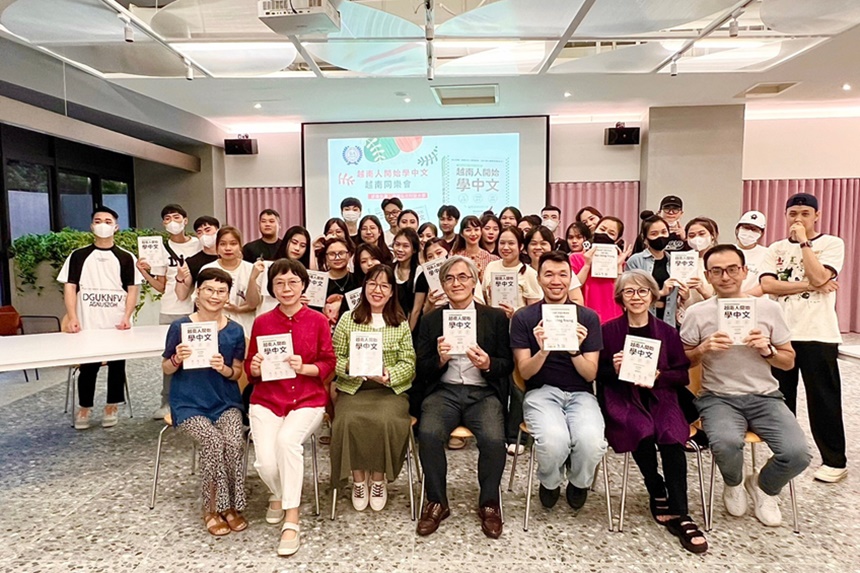In October, Hungkuang University held a “Vietnam Fellowship” event to welcome new Vietnamese students and Vietnamese students from the International College’s Mandarin Foundation Program. The Chinese Language Center of the Office of International Affairs arranged for Teacher Nguyen Ngoc Nguyet Mai to share her experiences in studying, living and teaching in Taiwan. They also gifted every student her new book “Vietnamese Start Learning Chinese”, hoping that through this beginner textbook tailored for Vietnamese language background and learning needs, students can quickly learn basic Chinese and pass the Chinese language proficiency test.
There are currently 42 Vietnamese students at Hungkuang University. Vice President Chang Tsung-min said that through fellowship events, the Chinese Language Center enables new students to interact with seniors, reducing unfamiliarity, facilitating freshmen’s integration into the campus learning environment and adaptation to life in Taiwan, while also providing them more resources for learning Chinese. Teacher Nguyen Ngoc Nguyet Mai shared that she came into contact with Taiwan when she worked after graduating from Can Tho University in Vietnam. In 2014, when she came to Taiwan to study Chinese and attended the MA program in Teaching Chinese as a Second Language at National Taiwan Normal University, she started teaching while studying. She discovered differences between textbooks in Vietnam, which mainly adopted simplified characters from mainland China, and Taiwan – in vocabulary, expressions, cultural introduction and more. There was also an extreme lack of traditional character teaching materials.
為歡迎越南籍新生及國際專修部華語先修班越南學生,弘光科技大學10月舉辦「越南同樂會」,國際處華語文中心除特別安排老師阮氏玉梅分享在台灣讀書、生活與教學的經驗,也贈送每位學生她著作的新書《越南人開始學中文》,盼透過這本以越南人的語言背景、學習需求作為出發點的繁體中文入門教材,讓學生早日學會基礎中文,通過華語文能力測驗。
目前弘光科大有42名越南籍學生,副校長張聰民表示,國際處華語文中心透過同學會活動,讓新生和學長姊互動交流,減少陌生感,促進新生融入校園學習環境及適應台灣生活,同時也讓他們有更多學習中文的資源。阮氏玉梅分享指出,她越南國立芹苴大學畢業就業時接觸到台灣,2014年到台灣學中文,就讀師範大學華語文教學系研究所之際,開始邊念書邊從事教學工作,發現越南中文課本主要採用中國大陸的簡體字教材,使用的詞彙、習慣用語、文化介紹和台灣不盡相同,繁體字教材非常缺乏。

Therefore, Nguyen Ngoc Nguyet Mai, who has long been engaged in bilingual teaching and translation between Chinese and Vietnamese, co-authored “Speaking Vietnamese from Scratch” last year with experienced Vietnamese teacher Wu Tingwei to teach Chinese speakers Vietnamese. This year, she further completed the book “Vietnamese Start Learning Chinese” on her own, hoping to guide Vietnamese students, new immigrants and migrant workers in learning basic Chinese with her personal experience and teaching expertise.
“In Taiwan, many teaching methods teach Vietnamese students Chinese indirectly in English, resulting in poor learning effects,” Nguyen Ngoc Nguyet Mai gave an example. There are six tones in Vietnamese pronunciation. Among them are the first, second and third tones in Chinese while the fourth tone is more difficult for Vietnamese students learning Chinese. There are also situations of consecutive two characters requiring tone change in the fourth tone, coupled with the large number of strokes in traditional Chinese characters that makes recognition difficult. Phonetic symbols are also not easy to understand. Therefore, her teaching materials have annotations of phonetic symbols and pinyin, with arrows indicating tones. Common traditional characters are also enlarged to simplify beginning Chinese learning.
Nguyen Ngoc Nguyet Mai said that the book “Vietnamese Start Learning Chinese” is specially designed for Test of Chinese as a Foreign Language (TOCFL) level A1-A2, making it extremely practical for Vietnamese students from Mandarin foundation programs. The book is divided into 12 daily life topics, 1000 words and 400 example sentences. Each topic includes conversations, new words, grammar, model sentences and practice to quickly enable learners to grasp relevant expressions for immediate application in real life situations.
Nguyen Ngoc Nguyet Mai emphasized that each topic in the book has an additional culture introduction unit on Taiwanese food, night markets, post offices, banks, transportation, attractions and more. Attached conversational examples are recorded by native Mandarin speakers. Students can listen and learn using MP3 cloud recordings to improve conversational competence and quickly integrate themselves into the Chinese-speaking world, finding common topics with locals in Taiwan.
因此,長期從事中文、越南語雙語教學及翻譯工作的阮氏玉梅,去年與資深越南語教師吳庭葳合著《從0開始說越南語》一書,教華人說越南語;今年更進一步獨自完成《越南人開始學中文》這本書,希望用親身經驗及教學專長,帶領越南學生、新住民、移工入門學基礎中文。
「在台灣很多教學方式是採用英文教越南學生中文,間接學習的效果不好。」阮氏玉梅舉例說,越南語發音有六個聲調,其中有中文的一聲、二聲、三聲,中文四聲發音對學習中文的越南學生來說比較困難,還有連續兩字四聲要變調的情形,加上繁體字筆劃多,辨認起來很困難,注音符號也不容易看懂,所以她編的教材有注音及拼音對照,加上箭頭來指示聲調,並把常用繁體字放大,讓著手學習中文變簡單。
阮氏玉梅表示,《越南人開始學中文》這本書專為考取華語文能力測驗 (TOCFL) A1- A2 級的程度設計,對華語先修班越南學生極為實用,全書分為12個生活主題、1000單字、400例句,每個主題都包含會話、生詞、語法、例句及練習,幫助學習者快速學會相關用語,馬上可以運用在生活實際情境中。
阮氏玉梅強調,書中每個主題後面均附加文化介紹單元,介紹台灣飲食、夜市、郵局、銀行、交通工具、指標景點等,所附的會話範例找華語母語人士錄製,用MP3雲端音檔邊聽邊學,能夠增進會話能力,讓學習者快速融入中文世界,和台灣當地人找到共同話題。

